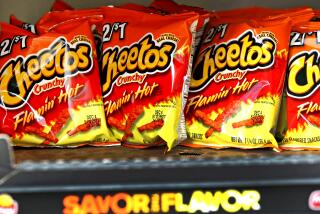Curbing our junk-food appetite
If only food were as simple as cigarettes. There are no ambiguities about the evils of smoking. It sickens people who do it and endangers those around them. Despite remarkable progress in persuading people not to take up the habit in recent decades, smoking is still the No. 1 preventable cause of death in this country, and it has no known health benefits.
Overeating, especially of low-nutrition junk food, is a bad habit too. Obesity is a fast-rising threat to American health. Yet, unlike with cigarettes, we can’t “quit” food. An occasional indulgence in dessert or potato chips is unlikely to hurt most of us as long as our overall diets are sound. While it is illegal to sell cigarettes to children, it’s not illegal to manufacture junk foods that are meant to appeal to children or to sell junk food to them.
Regulating the country’s way to slimness, then, is a complicated task, if it can be done at all. For the last two years, the Federal Trade Commission has headed up a multi-agency group attempting to tackle one corner of the obesity epidemic by proposing rules on the marketing of junk food to young children. Food commercials are a staple of children’s programming on television, and most of the ads are not pushing fresh broccoli and steamed halibut. The clever ads and promotions aimed at consumers who are too young to be aware that they’re being duped are a troubling part of life in the American marketplace; kids can be easily persuaded to do things that are unhealthy for them, and they have little concept of long-term consequences. The appealing advertising makes it harder for even conscientious parents to keep a lid on the amount of soda, sugared cereal and fast food in their children’s lives. The nagging for a Happy Meal can be nonstop, and the peer pressure is intense.
This spring, the FTC panel produced a preliminary set of voluntary guidelines for the food industry, a document that could be labeled “Advertise This, Not That.” It calls on companies to promote foods to children that contain fruits, vegetables, whole grains and other nutritious ingredients, and to steer away from marketing products high in saturated fat, sugar, salt and the like. After the public comment period (which ends June 13) and amendments, the guidelines would take effect in five years, enough time for food companies to reformulate their products and make them healthy — or at least healthier.
The guidelines have been fiercely criticized for being just that — guidelines, rather than mandates. We certainly don’t expect them to have a huge effect on American nutrition or obesity. The hope is that companies will feel pressure to comply voluntarily, but the reality is that companies will probably make just enough improvements in their foods, and remove enough of their most egregious ads, to look like good citizens. PepsiCo, which sells Fritos corn chips, Cracker Jack and many other snack foods along with its sodas, has been reformulating products on its own — experimenting, for instance, with salt crystals that give chips the same flavor with less sodium. The big profits are in processed foods, and as long as that’s true, Saturday morning cartoons will not be interrupted with pitches for homemade broiled chicken and brown rice but for somewhat more nutritious versions of the same old stuff.
Another concern about the guidelines is that there could be some odd inconsistencies regarding which products have the government’s blessing to be marketed and which don’t. A box of kiddie cereal might contain enough whole grain and sweetening via fruit juice instead of corn syrup to meet the government’s approval standards — even though many fruit juices have more sugar calories than soda and very little extra nutrition — while a container of reduced-fat milk might be considered too high in fat to be advertised to children.
And although the role of sugar in the widening of the American waistline has been well established, other aspects of nutrition are widely debated. Some doctors and dieticians feel that salt and saturated fats, especially coconut oil, have been unfairly demonized.
All in all, voluntary guidelines are a better idea than hard-and-fast rules. As long as companies are making a legal product, it defies reason to say that they cannot market that product to the audience it is intended for, especially when there’s legitimate disagreement about which products are more or less healthy.
But that doesn’t mean parents and schools have to allow and even encourage such marketing. For too long, schools were active allies of companies that sought to print their brand names on impressionable minds, forging contracts with them that were lucrative for both sides. Schools held Coca-Cola rallies and in one case disciplined a student who wore a Pepsi T-shirt instead. In many states, this sort of crass commercialization has been stopped by a combination of laws, school policies and a public outcry that led some companies to voluntarily pull their products from schools.
Consumers who are more aware of these issues — along with honest, truly informative food labeling — will do more to change American eating habits and the corporate food culture than an advertising ban, just as public education campaigns dramatically transformed attitudes toward cigarettes over the past few decades. PepsiCo is changing its foods not because of what the FTC says but because there is growing consumer demand for healthier products. And though food is more complicated than cigarettes, it’s not too hard to grasp the concept that a real food bargain isn’t the one that’s cheapest, but the one that gives people the most nutrition for their calories.
More to Read
A cure for the common opinion
Get thought-provoking perspectives with our weekly newsletter.
You may occasionally receive promotional content from the Los Angeles Times.






